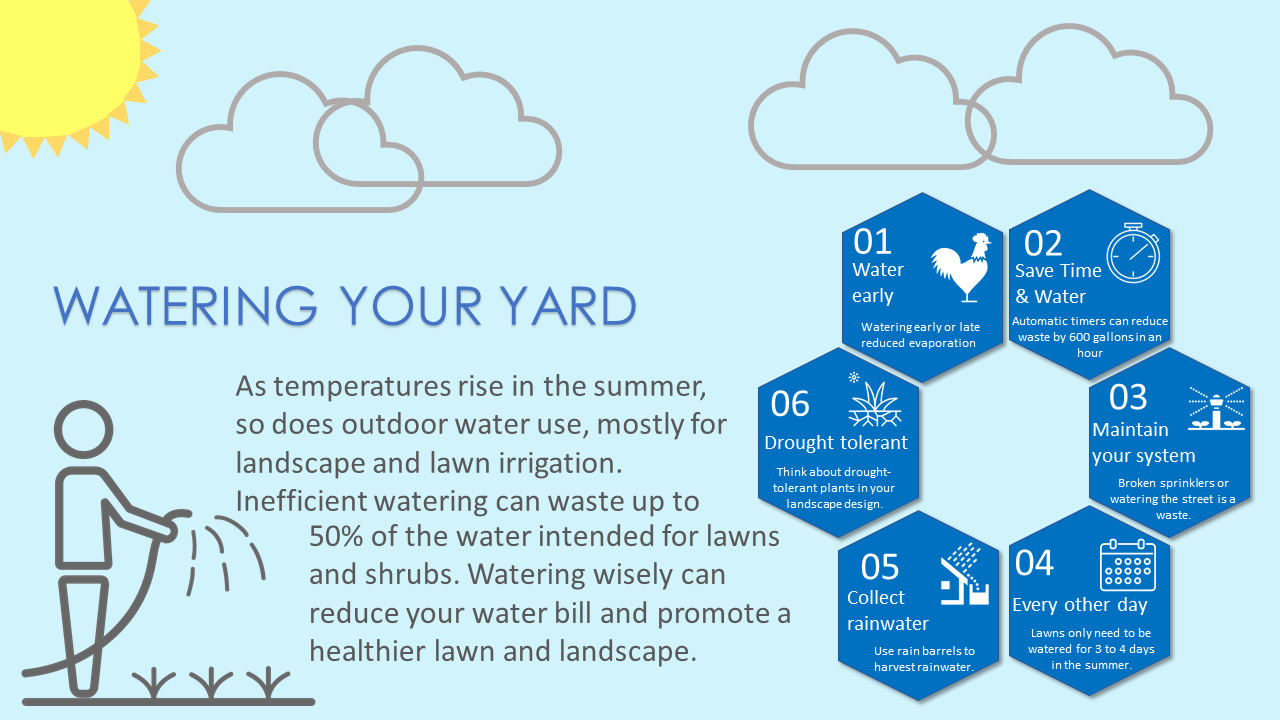Resources
- https://www.americanrivers.org/rivers/discover-your-river/top-10-ways-for-you-to-save-water-at-home/
- https://www.epa.gov/watersense/start-saving
- https://www3.epa.gov/region1/eco/drinkwater/water_conservation_residents.html
- Water your lawn early in the mornings to avoid evaporation and waste. A lawn only needs watering every other day or two in the summer months.
- Lawns only need about one-half to three-quarters of an inch of water at a time. To help determine how long it takes your irrigation system to reach those levels, place cups or cans throughout your yard and turn on your irrigation system. Once your system is done measure the amount of water in the cups or cans and adjust accordingly.
- Use water-efficient sprinklers and install rain sensors that override your system when it rains. Use drip systems for planting beds with shrubs and flowers. Make sure you are watering your landscape and not the driveway or street.
- If you don’t have automatic sprinklers set a timer. A garden hose left unattended can use up to 600 gallons of water in an hour.
- Consider planting drought-tolerant plants. Use mulch to retain moisture and reduce weeds.
- Raise your lawnmower blade to its highest setting – it encourages grass roots to grow deeper. Longer grass blades retain more moisture. Use fertilizer sparingly and try time release products.
- Learn how to read your meter. Read your meter before and after a two-hour period when no water is being used. If the readings are different, you have a leak.
- Repair dripping faucets by replacing the washers. If your faucet drips at one drip per second – you can waste 20 gallons of water every day.
- Run automatic dishwashers instead of hand washing – it can save water. Set washing machines to appropriate water level for the size of the load.
- Don’t let your toilet run. Detect toilet leaks by removing the lid from the toilet tank, remove any colored cleaning agents, flush to clear water in the bowl, then add a few drops of food coloring to the tank. If the tank is leaking, color will appear in the bowl within 30 minutes. To avoid staining the bowl, flush as soon as the test is complete. A leaky tank can waste 200 gallons of water each day. Replace worn, corroded or bent parts.
- Upgrade your shower head. New shower heads deliver 2.5 gallons of water per minute – that compares to older fixtures that can use up to nine gallons of water per minute.
Drip Irrigation
What is Drip Irrigation?
Drip irrigation is the slow, precise application of water directly to the plants’ root. A drip irrigation, micro-irrigation, system can be customized to meet your landscape’s specific needs while maintaining an optimum moisture level for your plants, efficiently conserving water that might otherwise be lost.
Related Links
Landscaping
Whether adding a few plants or redesigning your entire yard, incorporate a Waterwise design to save water, time and money.
Xeriscape
Xeriscape is a type of landscaping that reduces water use and incorporates native and drought tolerant planting. It also requires very little maintenance. Native plants only require trimming a few times a year and a basic treatment for weeds in spring time.
Plant Native and Drought Tolerant
Once established, these plants require little water beyond what Mother Nature provides. The WSU Extension Office has comprehensive lists of native and drought tolerant plants, shrubs and trees.
Related Links
Our customers use an average of 65,000 gallons of water annually. On average, a household leak can account for 10,000 gallons of water per year according to the Environmental Protection Agency (EPA). Leaks are oftentimes easy to fix and a great way to save on your monthly water bill. Fixing household leaks can save a typical homeowner 10% of their annual water bill.
During winter months, if a family of four uses more than 12,000 gallons or (16 hundred cubic feet (CCF)) of water – you may have a serious leak according to the EPA.
Here are some of EPA’s recommended steps for detecting a leak:
- Check your water meter before and after a two-hour period when no water is being used. If the meter changes at all, you probably leak.
- Identify toilet leaks by placing a drop of food coloring in the toilet tank. If any color shows up in the bowl after 10 minutes, you have a leak. (Be sure to flush immediately after the experiment to avoid staining the tank.)
- Examine faucet gaskets and pipe fittings for any water on the outside of the pipe to check for surface leaks.
- Use our checklist to keep track of your search for leaks: Detect and Chase Down Leaks at Home Checklist (PDF)
- WaterSense partners have guides and videos that you might find helpful in finding and fixing leaks.
- Arizona Municipal Water User’s Association has a great Smart Home Water Guide (PDF)
- Regional Water Providers Consortium in Oregon has several videos on detecting household leaks
- Thornton Water in Colorado provides tips and tricks to find hidden water waste
- Facts on Leaks


